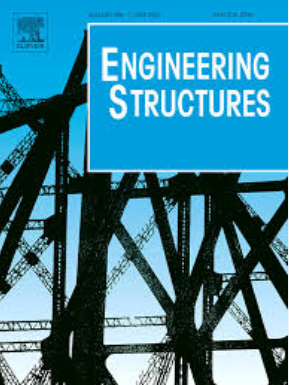新型八角形空心截面不锈钢短柱的局部屈曲
IF 5.6
1区 工程技术
Q1 ENGINEERING, CIVIL
引用次数: 0
摘要
八角形空心截面是一种新型的多边形空心截面,它结合了传统圆形和矩形空心截面的优点,同时减轻了它们的局限性,由于板单元宽度较小,它比矩形空心截面具有更高的承载能力,由于多个平面为焊接和螺栓连接提供了操作平台,它比圆形空心截面具有更好的可施工性。本文对不锈钢八角形空心截面在轴压作用下的局部屈曲行为进行了实验和数值研究。试验程序包括15个不锈钢八角形空心短柱试样的轴压试验,具有5种不同的外截面尺寸和3种不同的壁厚,以及拉伸接头试验和初始局部几何缺陷测量。在进行测试程序的同时,还进行了数值模拟程序,开发了有限元模型,并根据测试结果进行验证,然后采用有限元模型进行参数化研究。采用试验和数值数据,对欧洲规范、美国规范和ASCE标准中有关设计规则对不锈钢八角形空心截面的适用性进行了评价。评价结果普遍表明:(1)3套规范的长细限值在用于不锈钢六角空心截面分类时是不安全的;(2)欧洲规范和美国规范对不锈钢八角形空心截面抗压性能的预测总体上是准确和一致的。但对非细长截面的预测仍然过于保守,对非细长截面和细长截面边界的预测也略有不安全。(iii) ASCE标准对截面抗压阻力的预测总体上是分散的,不准确的。最后,提出了改进的三种设计规范的长细限值和修订的ASCE设计方法来预测截面抗压阻力。本文章由计算机程序翻译,如有差异,请以英文原文为准。
Local buckling of stainless steel stub columns with novel octagonal hollow sections
Octagonal hollow section, a novel type of polygonal hollow sections, combines the advantages of traditional circular and rectangular hollow sections while mitigating their limitations, with higher load-carrying capacities over rectangular hollow sections due to smaller plate element widths and better constructability over circular hollow sections owing to multiple flat faces providing operation platforms for welded and bolted connections. The present paper reports experimental and numerical studies on the local buckling behaviour of stainless steel octagonal hollow sections under axial compression. The testing programme included axial compression tests on fifteen stainless steel octagonal hollow section stub column specimens with five different outer cross-section dimensions and three different wall thicknesses, as well as tensile coupon tests and initial local geometric imperfection measurements. In parallel with the testing programme, a numerical modelling programme was carried out, with finite element models developed and validated against the test results and afterwards adopted to carry out parametric studies. The test and numerical data were used to evaluate the applicability of relevant design rules, as specified in the European code, American specification and ASCE standard, to stainless steel octagonal hollow sections. The evaluation results generally revealed that (i) the three sets of codified slenderness limits were unsafe when used for cross-section classification of stainless steel hexagonal hollow sections, (ii) the European code and American specification resulted in overall accurate and consistent cross-section compression resistance predictions for stainless steel octagonal hollow sections, but still with some overly conservative predictions for non-slender cross-sections and slightly unsafe predictions for those at the boundary of non-slender and slender cross-sections, and (iii) the ASCE standard provided overall scattered and inaccurate cross-section compression resistance predictions. Finally, improved slenderness limits for the three considered design codes and a revised ASCE design approach for predicting cross-section compression resistances were proposed.
求助全文
通过发布文献求助,成功后即可免费获取论文全文。
去求助
来源期刊

Engineering Structures
工程技术-工程:土木
CiteScore
10.20
自引率
14.50%
发文量
1385
审稿时长
67 days
期刊介绍:
Engineering Structures provides a forum for a broad blend of scientific and technical papers to reflect the evolving needs of the structural engineering and structural mechanics communities. Particularly welcome are contributions dealing with applications of structural engineering and mechanics principles in all areas of technology. The journal aspires to a broad and integrated coverage of the effects of dynamic loadings and of the modelling techniques whereby the structural response to these loadings may be computed.
The scope of Engineering Structures encompasses, but is not restricted to, the following areas: infrastructure engineering; earthquake engineering; structure-fluid-soil interaction; wind engineering; fire engineering; blast engineering; structural reliability/stability; life assessment/integrity; structural health monitoring; multi-hazard engineering; structural dynamics; optimization; expert systems; experimental modelling; performance-based design; multiscale analysis; value engineering.
Topics of interest include: tall buildings; innovative structures; environmentally responsive structures; bridges; stadiums; commercial and public buildings; transmission towers; television and telecommunication masts; foldable structures; cooling towers; plates and shells; suspension structures; protective structures; smart structures; nuclear reactors; dams; pressure vessels; pipelines; tunnels.
Engineering Structures also publishes review articles, short communications and discussions, book reviews, and a diary on international events related to any aspect of structural engineering.
 求助内容:
求助内容: 应助结果提醒方式:
应助结果提醒方式:


